Yizhu Wang
Throughput Optimization in Cache-aided Networks: An Opportunistic Probing and Scheduling Approach
Sep 02, 2024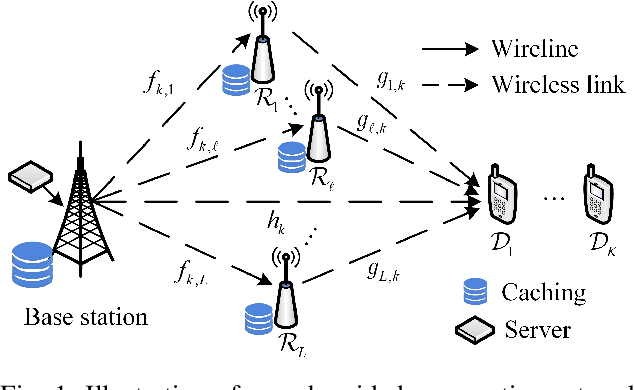
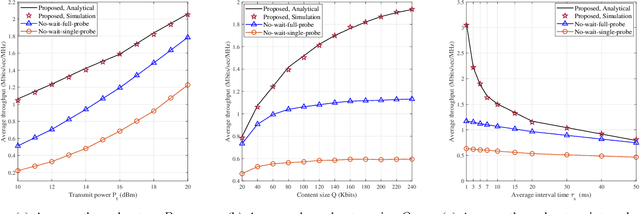
Abstract:This paper addresses the challenges of throughput optimization in wireless cache-aided cooperative networks. We propose an opportunistic cooperative probing and scheduling strategy for efficient content delivery. The strategy involves the base station probing the relaying channels and cache states of multiple cooperative nodes, thereby enabling opportunistic user scheduling for content delivery. Leveraging the theory of Sequentially Planned Decision (SPD) optimization, we dynamically formulate decisions on cooperative probing and stopping time. Our proposed Reward Expected Thresholds (RET)-based strategy optimizes opportunistic probing and scheduling. This approach significantly enhances system throughput by exploiting gains from local caching, cooperative transmission and time diversity. Simulations confirm the effectiveness and practicality of the proposed Media Access Control (MAC) strategy.
Dynamic Cooperative MAC Optimization in RSU-Enhanced VANETs: A Distributed Approach
Feb 14, 2024Abstract:This paper presents an optimization approach for cooperative Medium Access Control (MAC) techniques in Vehicular Ad Hoc Networks (VANETs) equipped with Roadside Unit (RSU) to enhance network throughput. Our method employs a distributed cooperative MAC scheme based on Carrier Sense Multiple Access with Collision Avoidance (CSMA/CA) protocol, featuring selective RSU probing and adaptive transmission. It utilizes a dual timescale channel access framework, with a ``large-scale'' phase accounting for gradual changes in vehicle locations and a ``small-scale'' phase adapting to rapid channel fluctuations. We propose the RSU Probing and Cooperative Access (RPCA) strategy, a two-stage approach based on dynamic inter-vehicle distances from the RSU. Using optimal sequential planned decision theory, we rigorously prove its optimality in maximizing average system throughput per large-scale phase. For practical implementation in VANETs, we develop a distributed MAC algorithm with periodic location updates. It adjusts thresholds based on inter-vehicle and vehicle-RSU distances during the large-scale phase and accesses channels following the RPCA strategy with updated thresholds during the small-scale phase. Simulation results confirm the effectiveness and efficiency of our algorithm.
Distributed CSMA/CA MAC Protocol for RIS-Assisted Networks
Sep 21, 2023Abstract:This paper focuses on achieving optimal multi-user channel access in distributed networks using a reconfigurable intelligent surface (RIS). The network includes wireless channels with direct links between users and RIS links connecting users to the RIS. To maximize average system throughput, an optimal channel access strategy is proposed, considering the trade-off between exploiting spatial diversity gain with RIS assistance and the overhead of channel probing. The paper proposes an optimal distributed Carrier Sense Multiple Access with Collision Avoidance (CSMA/CA) strategy with opportunistic RIS assistance, based on statistics theory of optimal sequential observation planned decision. Each source-destination pair makes decisions regarding the use of direct links and/or probing source-RIS-destination links. Channel access occurs in a distributed manner after successful channel contention. The optimality of the strategy is rigorously derived using multiple-level pure thresholds. A distributed algorithm, which achieves significantly lower online complexity at $O(1)$, is developed to implement the proposed strategy. Numerical simulations verify the theoretical results and demonstrate the superior performance compared to existing approaches.
Intrinsic Gaussian Process on Unknown Manifolds with Probabilistic Metrics
Jan 16, 2023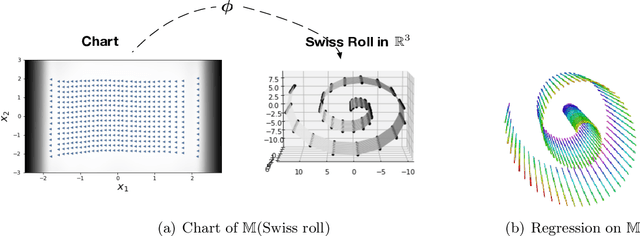

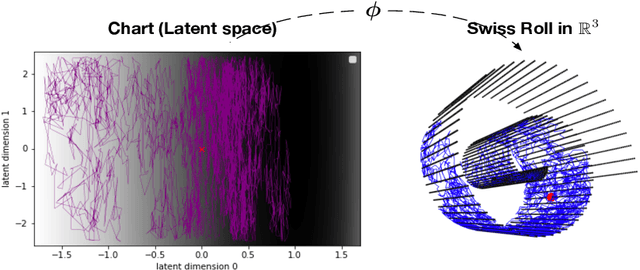
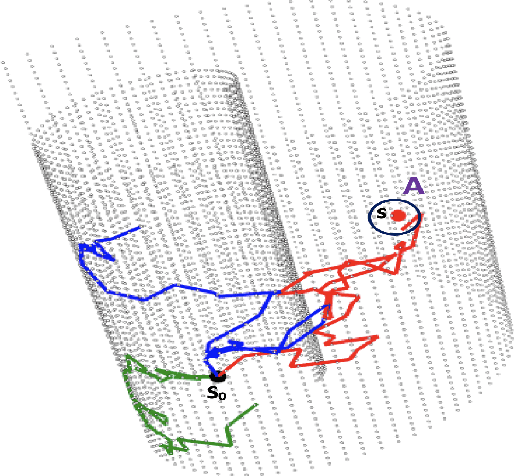
Abstract:This article presents a novel approach to construct Intrinsic Gaussian Processes for regression on unknown manifolds with probabilistic metrics (GPUM) in point clouds. In many real world applications, one often encounters high dimensional data (e.g. point cloud data) centred around some lower dimensional unknown manifolds. The geometry of manifold is in general different from the usual Euclidean geometry. Naively applying traditional smoothing methods such as Euclidean Gaussian Processes (GPs) to manifold valued data and so ignoring the geometry of the space can potentially lead to highly misleading predictions and inferences. A manifold embedded in a high dimensional Euclidean space can be well described by a probabilistic mapping function and the corresponding latent space. We investigate the geometrical structure of the unknown manifolds using the Bayesian Gaussian Processes latent variable models(BGPLVM) and Riemannian geometry. The distribution of the metric tensor is learned using BGPLVM. The boundary of the resulting manifold is defined based on the uncertainty quantification of the mapping. We use the the probabilistic metric tensor to simulate Brownian Motion paths on the unknown manifold. The heat kernel is estimated as the transition density of Brownian Motion and used as the covariance functions of GPUM. The applications of GPUM are illustrated in the simulation studies on the Swiss roll, high dimensional real datasets of WiFi signals and image data examples. Its performance is compared with the Graph Laplacian GP, Graph Matern GP and Euclidean GP.
A Regression Approach to Certain Information Transmission Problems
Jun 10, 2019
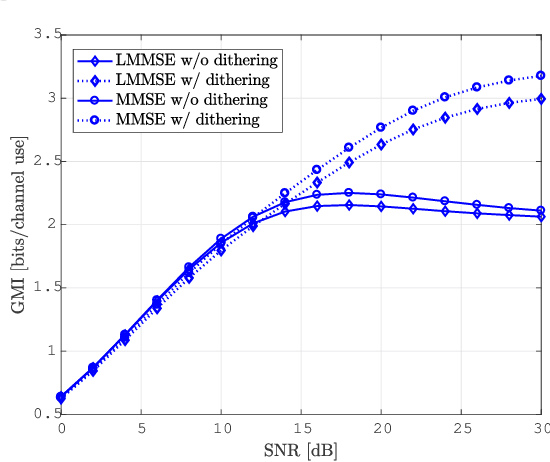
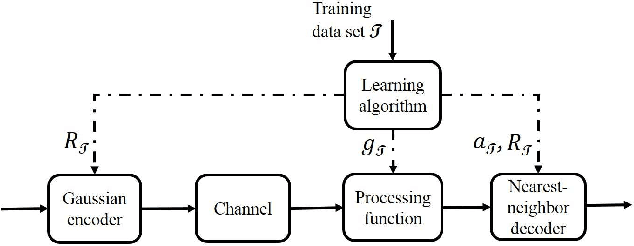
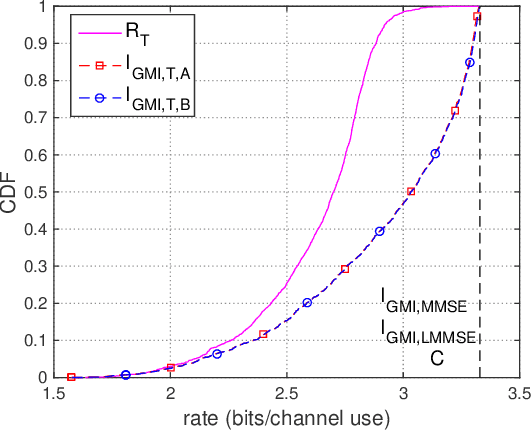
Abstract:A general information transmission model, under independent and identically distributed Gaussian codebook and nearest neighbor decoding rule with processed channel output, is investigated using the performance metric of generalized mutual information. When the encoder and the decoder know the statistical channel model, it is found that the optimal channel output processing function is the conditional expectation operator, thus hinting a potential role of regression, a classical topic in machine learning, for this model. Without utilizing the statistical channel model, a problem formulation inspired by machine learning principles is established, with suitable performance metrics introduced. A data-driven inference algorithm is proposed to solve the problem, and the effectiveness of the algorithm is validated via numerical experiments. Extensions to more general information transmission models are also discussed.
 Add to Chrome
Add to Chrome Add to Firefox
Add to Firefox Add to Edge
Add to Edge